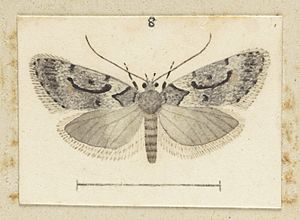Izatha manubriata facts for kids
Quick facts for kids Izatha manubriata |
|
|---|---|
 |
|
| Scientific classification | |
| Kingdom: | |
| Phylum: | |
| Class: | |
| Order: | |
| Family: |
Oecophoridae
|
| Genus: | |
| Species: |
I. manubriata
|
| Binomial name | |
| Izatha manubriata Meyrick, 1923
|
|
The Izatha manubriata is a special kind of moth. It belongs to a group of moths called Oecophoridae. This moth only lives in New Zealand, especially in the southern part of the South Island. This means it's an endemic species, found nowhere else in the world!
Contents
Discovering the Moth
A scientist named Edward Meyrick first described this moth in 1923. He studied a moth collected by George Hudson. George found it in a forest near Ben Lomond, by Lake Wakatipu, in January.
George Hudson also wrote about and drew this moth. He included it in his 1928 book, The Butterflies and Moths of New Zealand. The original moth specimen, called the holotype, is kept safe at the Natural History Museum, London.
What Does It Look Like?
This moth is quite small. The males have a wingspan (the distance from one wingtip to the other) of about 24.5 to 27.5 millimeters. Females are a bit smaller, with a wingspan of around 26 millimeters.
It has a unique pattern on its wings. This pattern helps scientists easily tell it apart from other moths in the Izatha group that live in the South Island. Its body and wings are mostly grey, mixed with white. It also has some blackish spots and lines.
Where Does It Live?
The Izatha manubriata moth is only found in New Zealand. It mainly lives in the Otago Lakes district and the nearby mountains of Central Otago.
Besides its first discovery spot at Ben Lomond, this moth has been seen in other places. These include Mount Aurum, Bold Peak, Queenstown, Moke Lake, Lake Wakatipu, the Garvie Mountains, and Pomahaka Valley. George Hudson thought this moth was quite rare.
Life and Habits
Adult Izatha manubriata moths can be seen flying from December to early March.
Scientists still have a lot to learn about this moth's life. For example, no one has ever found or studied its larvae (the caterpillar stage). This means we don't know much about its full life cycle or how it behaves when it's young. So far, only one female moth of this species has ever been collected!
Home and Food
George Hudson noted that these moths like to live near the edges of beech forests in the mountains. This suggests they might depend on these forests for shelter or food. However, since their larvae haven't been found, their exact host plants (the plants they eat) are still a mystery.

